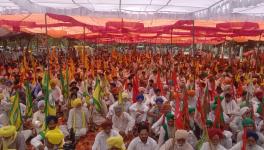Mr Tomar, Listen to What These Farmers Have to Say About Cash Crops!

New Delhi: Bhim Rao Gondane is eagerly looking out for flags, banners, placards and flex posters in the temporary camp at Delhi’s Singhu Border. He and his friends from Nagpur district of Maharashtra have come all the way to lend their support to the agitating farmers camping at the border against the recently enacted three farm laws and the proposed Electricity Amendment Bill.
A conversation with Gondane lay bare the bitter truth that has emboldened the farmers’ resolve to fight for a law enabling purchase at minimum support price (MSP). Gondane, who hails from Ram Tek in Nagpur, said the farmers in the arid region have been growing cash crops, like cotton, soyabean, tomato and toor dal, to compensate for the losses arising of one crop season.
Talking to NewsClick, Goandane says: “Much of the land in our region is unirrigated and farmers are entirely dependent on rains for their harvest. Thus, we only grow one crop in the year. It’s sheer gamble. If you get good and timely rains, you have some chances of returns, otherwise you are doomed.”
Gondane, a small farmer with two acres, grew cotton in his farms and explains the input costs and the returns associated with it. “The sowing of the crop starts with ploughing and making queues for plantation. This cost me Rs 2,800. Then we plant seeds, for which I pay Rs 1,250 per acre. After waiting for three months, we apply for DAP fertiliser once the sappling grows. This cost and additional Rs 2,000. Since we are required to consistently look for weeds, we employ workers to remove these. The workers charge about Rs 1,500. Two months later, we introduce another spell of fertiliser which generally costs Rs 3,000. Since it’s a labour- intensive crop, the plucking of the cotton is done by hands and workers charge Rs 6,000 per acre. So, the total cost is about Rs 16,000 per acre. We grow about six quintals of cotton in an acre, which I sold for Rs 5,300 per quintal. So my saving per acre is Rs 15,800. Since we only grow one crop, I am basically earning Rs 1,300 per month. And I am talking about returns in perfect weather with timely rains which we are not getting for years now. I think that explains why we are going for suicides!”
When asked about the response of the political parties in Maharashtra towards the crisis, he said: “They take the name of Vidarbha only to build their image and persona but have done nothing, such as Nitin Gadkari, Devendra Fadnavis (BJP leaders) and some others. Congress is no better. My Lok Sabha constituency gave India its Prime Minister Narasimha Rao. He never looked back to see our plight!”
Incidentally, former Prime Minister P V Narasimha Rao of Congress, represented Ram Tek constituency in Nagpur, twice – in 1984 and 1989 – as Lok Sabha member. He later became the PM.
Sitting besides Gondane, Chandu Rao, another marginal farmer, intervenes to explain how their experiments with cash crops have wreaked havoc. Rao grew soyabean in his two-acre farm. “I invested about Rs 10,000 per acre in seeds, ploughing and fertilisers. But excessive rains ruined everything. The weeds grew so wild that it was impossible to remove them. I had no option but to mow down the crop.”
Digambar Diwate, a member of Maharashtra Kisan Sabha, says his family, too, met a similar fate when they grew tomato. His village is famous for tomato produce, and is known as ‘Ambazari Tomato’ in the region. “Once our crop was destroyed and we knew it was futile to invest any further.” However, he has other complaints about the procurement process by government agencies.
“They know well that this region is full of tribal communities who desperately need government support to survive. Despite this, they have fixed the bar of lifting at eight quintals per acre from farmers. Now, I grow about 20 quintals paddy in one acre. So, I am forced to sell the remaining 12 quintals in the open market much below the MSP. Also, the agencies deliberately open the buying centres on December 15, when they know our crop is ready by first week of November. They know that we cannot store the produce for long. Above all, a person with any self-respect does not want recovery agents outside his doors. Thus, we sell our produce at throw-away prices to pay for our borrowings.”
Raju Hatwar, another farmer, intervenes: “Why would they procure the entire produce when Food Corporation of India does not have enough storage. They have neither upgraded the warehouses nor built new ones. They are contracting with Adani for storage in other states. This is why, people are more worried.”
Narrating the vicious circle of debt and suicides, Diwate says: “The banks know that our crops have turned rotten in farms and they would not get the payments. So, they send back the farmers seeking loans next year. We have no option but turn to moneylenders for borrowing at 10% interest per month, which effectively means, I pay 220% on borrowed money in a year.”
However, when asked about the ongoing farmers’ movement and its impact, he has an interesting reply. “Jab tak aap sarkar ki naak nahin dabayenge, wo muh nahi kholegi. Kisan sarkar ka muh khulawane aaye hain.” (Till we don’t tightly squeeze the government’s nose, it won’t open its mouth) We are very clear about our agenda. They say India is a country of farmers and workers. Now, the time has come when they must listen to us,” says Diwate.
Get the latest reports & analysis with people's perspective on Protests, movements & deep analytical videos, discussions of the current affairs in your Telegram app. Subscribe to NewsClick's Telegram channel & get Real-Time updates on stories, as they get published on our website.
























